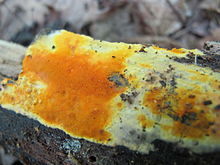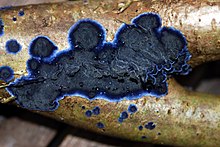| Phanerochaetaceae | |
|---|---|

| |
| Phanerochaete velutina | |
| Scientific classification | |
| Domain: | Eukaryota |
| Kingdom: | Fungi |
| Division: | Basidiomycota |
| Class: | Agaricomycetes |
| Order: | Polyporales |
| Family: | Phanerochaetaceae Jülich (1982) |
| Type genus | |
| Phanerochaete P.Karst (1889) | |
| Synonyms | |
| |
The Phanerochaetaceae are a family of mostly crust fungi in the order Polyporales.
Taxonomy
Phanerochaetaceae was first conceived by Swedish mycologist John Eriksson in 1958 as the subfamily Phanerochaetoideae of the Corticiaceae. It was later published validly by Erast Parmasto in 1986, and raised to familial status by Swiss mycologist Walter Jülich in 1982. The type genus is Phanerochaete.
In 2007, Karl-Henrik Larsson proposed using the name Phanerochaetaceae to refer to the clade of crust fungi clustered near Phanerochaete. In 2013, a more extensive molecular analysis showed that the Phanerochaetaceae were a subclade of the large phlebioid clade, which also contains members of the families Meruliaceae and Irpicaceae. The generic limits of Phanerochaete were revised in 2015, and new genera were added in 2016. As of April 2018, Index Fungorum accepts 30 genera and 367 species in the family.
Description
Most Phanerochaetaceae species are crust-like. Their hyphal system is monomitic (containing only generative hyphae), and these hyphae lack clamp connections. Their spores are thin-walled, smooth, and hyaline (translucent). Cystidia are often present in the hymenium. Although rare, some species have a polyporoid form, a dimitic hyphal system, and clamp connections. Phanerochaetaceae fungi produce a white rot.
Genera


- Amethicium Hjortstam (1983); 1 species
- Australicium Hjortstam & Ryvarden (2002); 2 species
- Australohydnum Jülich (1978); 2 species
- Byssomerulius Parmasto (1967); 12 species
- Candelabrochaete Boidin (1970); 12 species
- Ceriporia Donk (1933); 49 species
- Ceriporiopsis Domański (1963); 34 species
- Climacodon P.Karst. (1881); 7 species
- Geliporus Yuan Yuan, Jia J.Chen & S.H.He (2017)
- Hjortstamia Boidin & Gilles (2003); 13 species
- Hyphodermella J.Erikss. & Ryvarden (1976); 6 species
- Inflatostereum D.A.Reid (1965); 2 species
- Meruliopsis Bondartsev (1959); 2 species
- Meruliporia Murrill (1942)
- Odontoefibula Che C. Chen & Sheng H. Wu (2018); 1 species
- Oxychaete Miettinen (2016); 1 species
- Phanerina Miettinen (2016); 1 species
- Phanerochaete P.Karst. (1889); 92 species
- Phanerodontia Hjortstam & Ryvarden (2010); 4 species
- Phaneroites Hjortstam & Ryvarden (2010); 1 species
- Phlebiopsis Jülich (1978); 12 species
- Porostereum Pilát (1937); 4 species
- Pouzaroporia Vampola (1992); 1 species
- Pseudolagarobasidium J.C.Jang & T.Chen (1985); 9 species
- Rhizochaete Gresl., Nakasone & Rajchenb. (2004); 6 species
- Riopa D.A.Reid (1969); 2 species
- Roseograndinia Hjortstam & Ryvarden (2005); 1 species
- Terana Adans. (1763); 1 species
References
- ^ Justo, Alfredo; Miettinen, Otto; Floudas, Dimitrios; Ortiz-Santana, Beatriz; Sjökvist, Elisabet; Lindner, Daniel; Nakasone, Karen; Niemelä, Tuomo; Larsson, Karl-Henrik; Ryvarden, Leif; Hibbett, David S. (2017). "A revised family-level classification of the Polyporales (Basidiomycota)". Fungal Biology. 121 (9): 798–824. Bibcode:2017FunB..121..798J. doi:10.1016/j.funbio.2017.05.010. PMID 28800851.
- Eriksson, John (1958). "Studies in the Heterobasidiomycetes and Homobasidiomycetes-Aphyllophorales of Muddus national park in North Sweden". Symbolae Botanicae Upsalienses. 16 (1). Uppsala: Lundequistska bokhandeln: 1–172.
{{cite journal}}: Cite journal requires|journal=(help) - Parmasto, E. (1986). "On the origin of the Hymenomycetes (What are corticioid fungi?)". Windahlia. 16: 3–19.
- Jülich, Walter (1981). Higher Taxa of Basidiomycetes. Bibliotheca Mycologica. Vol. 85. J. Cramer. p. 384. ISBN 978-3768213240.
- Larsson, Karl-Henrik (2007). "Re-thinking the classification of corticioid fungi". Mycological Research. 111 (9): 1040–1063. doi:10.1016/j.mycres.2007.08.001. PMID 17981020.
- Binder, Manfred; Justo, Alfredo; Riley, Robert; Salamov, Asaf; Lopez-Giraldez, Francesc; Sjökvist, Elisabet; Copeland, Alex; Foster, Brian; Sun, Hui; Larsson, Ellen; Larsson, Karl-Henrik; Townsend, Jeffrey; Grigoriev, Igor V.; Hibbett, David S. (2013). "Phylogenetic and phylogenomic overview of the Polyporales". Mycologia. 105 (6): 1350–1373. doi:10.3852/13-003. PMID 23935031. S2CID 20812924.
- Floudas, Dimitrios; Hibbett, David S. (2015). "Revisiting the taxonomy of Phanerochaete (Polyporales, Basidiomycota) using a four gene dataset and extensive ITS sampling". Fungal Biology. 119 (8): 679–719. Bibcode:2015FunB..119..679F. doi:10.1016/j.funbio.2015.04.003. PMID 26228559.
- ^ Miettinen, Otto; Spirin, Viacheslav; Vlasák, Josef; Rivoire, Bernard; Stenroos, Spoili; Hibbett, David S. (2016). "Polypores and genus concepts in Phanerochaetaceae (Polyporales, Basidiomycota)". MycoKeys (17): 1–46. doi:10.3897/mycokeys.17.10153. hdl:10138/170328.
- Kirk, P.M. (ed.). "Species Fungorum (version 28th March 2018). In: Species 2000 & ITIS Catalogue of Life". Archived from the original on 29 April 2018. Retrieved 9 April 2018.
- Hjortstam, Kurt (1983). "Studies in tropical Corticiaceae (Basidiomycetes). V. Specimens from East Africa collected by L. Ryvarden". Mycotaxon. 17: 555–572.
- Hjortstam, Kurt; Ryvarden, Leif (2002). "Australicium (Basidiomycotina, Aphyllophorales) a new genus for Corticium singulare G. Cunn". Synopsis Fungorum. 15: 18–21.
- Jülich W. (1978). "Studies in resupinate basidiomycetes – V". Persoonia. 10 (1): 137–40.
- Parmasto, E. (1967). "Corticiaceae URSS IV. Descriptiones taxorum novorum. Combinationes novae". Eesti NSV Teaduste Akadeemia Toimetised, Biologica (in Latin). 16: 383.
- Boidin, J. (1970). "Basidiomycètes de la République Centralafricaine. II. - Les genres Botryobasidium Donk et Candelabrochaete nov. gen". Cahiers de la Maboké (in French). 8: 17–25.
- Donk, M.A. (1933). "Revisie van de Nederlandse Heterobasidiomyceteae (uitgez. Uredinales en Ustilaginales) en Homobasidiomyceteae-Aphyllophraceae: II. Mededelingen van het botanisch Museum en Herbarium van de Rijksuniversiteit Utrecht" (in Dutch). 9: 170.
{{cite journal}}: Cite journal requires|journal=(help) - Domanski, S. (1963). "Dwa nowe rodzaje grzybów z grupy "Poria Pers. ex S.F. Gray"". Acta Societatis Botanicorum Poloniae (in Polish). 32: 731–9. doi:10.5586/asbp.1963.044.
- Yuan, Yuan; Chen, Jia-Jia; He, Shuang-Hui (2017). "Geliporus exilisporus gen. et comb. nov., a xanthochroic polypore in Phanerochaetaceae from China". Mycoscience. 58 (3): 197–203. doi:10.1016/j.myc.2017.01.006.
- Boidin, J.; Gilles, G. (2002). "À propos du genre Lopharia sensu lato (Basidiomycètes, Aphyllophorales)". Bulletin de la Société Mycologique de France (in French). 118 (2): 91–155.
- Reid, D.A. (1965). A Monograph of the Stipitate Steroid Fungi. Beihefte zur Nova Hedwigia. Vol. 18. Lubrecht & Cramer. p. 143. ISBN 978-3-7682-5418-2.
- Chen C-C, Wu S-H, Chen C-Y (2018). "Hydnophanerochaete and Odontoefibula, two new genera of phanerochaetoid fungi (Polyporales, Basidiomycota) from East Asia". MycoKeys (39): 75–96. doi:10.3897/mycokeys.39.28010. PMID 30271259.
- ^ Hjortstam, K.; Ryvarden, L. (2010). "Phanerodontia and Phaneroites, two corticioid taxa (Basidiomycotina) proposed from tropical areas". Synopsis Fungorum. 27: 26–33.
- Jang, J.; Chen, T. (1985). "Pseudolagarobasidium leguminicola gen. et sp. nov. on Leucaena in Taiwan". Transactions of the British Mycological Society. 85 (2): 374–377. doi:10.1016/s0007-1536(85)80209-6.
- Greslebin, Alina; Nakasone, Karen K.; Rajchenberg, Mario (2004). "Rhizochaete, a new genus of phanerochaetoid fungi". Mycologia. 96 (2): 260–271. doi:10.2307/3762062. JSTOR 3762062. PMID 21148853.
- Hjortstam, Kurt; Ryvarden, Leif (2005). "New taxa and new combinations in tropical corticioid fungi, (Basidiomycotina, Aphyllophorales)". Synopsis Fungorum. 20: 33–41.